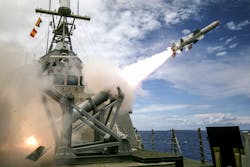Navy orders radar-guided Harpoon anti-ship missile with GPS guidance kit for in-flight navigation changes
PATUXENT RIVER NAS, Md. – U.S. Navy missile experts are asking the Boeing Co. to build 24 Harpoon anti-ship missiles under terms of a $15.6 million order announced Wednesday.
Officials of the Naval Air Systems Command at Patuxent River Naval Air Station, Md., are asking the Boeing Co. Defense, Space & Security segment in St. Louis to build 24 Harpoon Block II+ tactical missiles and 25 captive air training missiles.
The Harpoon is an all-weather, over-the-horizon, anti-ship missile, developed and manufactured by McDonnell Douglas before its 1997 acquisition by Boeing. The missile first was delivered in 1977.
Harpoon Block II+ version of the missile also is an over-the-horizon anti-ship missile with an improved GPS guidance kit and a networked enabled data link that enables the missile to receive in-flight targeting updates.
The U.S. Navy is deploying the Harpoon Block II+ by upgrading the existing Navy inventory of Harpoon IC missiles.
Captive air training missiles have no explosive warhead, and are used for pilot training in aerial target acquisition and aircraft controls and displays. They have tactical and training components.
The radar-guided Harpoon missile is designed to fly low enough to avoid air-defense radar. It can launch from fixed-wing aircraft, surface warships, submarines, coastal defense installations.
The Harpoon Block II offers an expanded engagement envelope, enhanced resistance to electronic countermeasure,s and improved targeting. It can operate reliably in the open ocean, as well as in coastal waters and harbors.
The Harpoon Block II has an inertial measurement unit (IMU), satellite guidance, and improved software. The Block II version has been in production since 2011. The missile and booster together weigh 1523 pounds, are 12.6 feet long, 13.5 inches in diameter, and carry a 488-pound explosive warhead.
These missiles can fire form U.S. and allied fixed-wing aircraft, surface ships, submarines, and coastal-defense batteries. Aircraft equipped with the Harpoon include the F/A-18 Hornet fighter-bomber, P-8A Poseidon maritime patrol aircraft, and the B-52H bomber.
On this order Boeing will do the work in St. Louis; Galena, Kan.; Lititz, Pa.; McAlester, Okla.; Anniston, Ala.; Chatsworth, Calif.; Minneapolis; Chandler, Ariz.; Cedar Rapids, Iowa; and other continental U.S. locations, and should be finished by August 2023.
For more information contact Boeing Defense, Space & Security online at www.boeing.com/company/about-bds/, or Naval Air Systems Command at www.navair.navy.mil.

John Keller | Editor-in-Chief
John Keller is the Editor-in-Chief, Military & Aerospace Electronics Magazine--provides extensive coverage and analysis of enabling electronics and optoelectronic technologies in military, space and commercial aviation applications. John has been a member of the Military & Aerospace Electronics staff since 1989 and chief editor since 1995.

